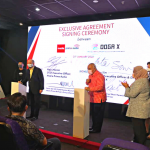Audio advertising: Hitting the right note with Malaysian listeners
By Joanna Wong, Head of Business Marketing, Spotify, Southeast Asia

Today, consumers are constantly bombarded with messages from every platform available on a daily basis. However, as marketers, we need to ask the question, is this truly effective?
Content marketing in the age of data often focuses on understanding what people are doing rather than how they are feeling. Consumer decisions rely heavily on emotions they experience too. With that in mind, it is important for advertising and marketing executives to understand the importance of the change that is happening in the industry.
The wind of change is here
With today’s Generation Z defining what is mainstream, brands need to open to change and one way of doing that is embracing the fact that we are addressing a new market; a new generation. In addition to that, brands need to be open on exploring the various platforms and modes of advertising.
In the advertising world, 2017 can be seen as a transitional year for publishers and platforms. Print media’s shift to digital is nearly complete, and it is predicted that budget allocated to traditional media will see another huge drop this year. Keeping up with the similar trend, television advertising has accelerated its shift to digital, favouring premium video apps like Netflix and mass-reach platforms like Facebook, YouTube and Snapchat.
Web publishers that don’t offer a differentiated experience will potentially lose consumer attention – and associated advertisers – to scaled platforms. And finally, radio is still early in its shift and is expected to ultimately transition to digital audio platforms over time. As technology continues to evolve, brands and marketers need to be highly attuned to their customers’ journey; ensuring that it is relevant and efficient.
Engage, connect & understand; the only way forward for advertisers
Consumers are looking for content that would complement and represent moments that are relevant in their lives. By reaching audiences during moments that matter to them, brands can now leverage their content with personalized messages to their user, based on the user’s state of mind.
These moments which matter to consumers should matter to brands too as they present a remarkable opportunity for brands to connect with consumers on a deeper level. Unlike demographics or device IDs which are often used to approximate a target audience, moments reveal profound insights about consumers, giving brands the possibility to truly achieve perceptive advertising.
The unique ability of micro-moments to flex to consumers’ need, makes it an especially powerful marketing tool, as brands reach their audience when they’re most engaged, with personalized content that matches their moment.
Although there is a shift, digital ads are still far from living up to their potential, often interrupting the consumer’s favourite content instead of adding value to the experience. Brands tend to fall into the trap of marketing to machines, and not to the consumer directly. Traditional method of using a cookie to profile a shopper and retargeting them may be seen as effective when compared to blind targeting.
Another point of consideration that many miss out is the viewability (or positioning) of their advertisement; above or below the fold? As a rule of thumb, what appears at the top of the page as compared to what is hidden will influence the consumer’s experience, regardless of the screen size.
Personalization must move beyond “targeting”
P&G’s Marc Pritchard has spoken at length about the problems that marketers have identified about programmatic ad placement. Knowing when and where to serve an ad is as important as who and what to serve.
For example, don’t ask a consumer to click an ad if they are driving in a car, or target a “fitness enthusiast” to fill out a form while in the middle of an intense workout. Understanding consumer context and mood are incredibly important and increasingly possible with everything becoming connected. According to IHS, the number of connected devices will grow to 30.7 billion in 2020.
As people increasingly consume media across devices, the marketing landscape is shifting towards people-based marketing.
“People-based marketing represents an industry shift from targeting devices to connecting with the right people at the right time, with the right message. Rather than targeting ads to devices based on cookies, which is fraught with inadequacies, marketers can now reach people across the many devices they use, thanks to persistent identity.” – Danielle Lee, VP, Global Head of Partner Solutions at Spotify.
According to Nielsen, 79% of audio is consumed while people are engaged in activities where visual media can’t reach them, whether it’s hitting the treadmill after work, or even channelling your inner rock star in the shower.
Today the priority is about having access to content, rather than owning content. For example, Spotify users spend at least 148 minutes a day listening to music through the Spotify platform. Music streaming is definitely growing and is more prevalent than TV or movie streaming in almost every moment of the day. Music is 5 times more likely to be streamed than TV or movie content, working out (3.5 times more likely) or focusing (3 times more likely); with 60% of music streamers listening on mobile, compared to 40% of TV and movie streamers.
Understanding people through music and why it matters
Savvy marketers will quickly embrace the consumer shift, and audio advertising will be reimagined through the lens of native experiences as opposed to terrestrial radio adaptations. Through streaming intelligence, we build audience experiences that fuel engagement and trust; one way Spotify is able to do that is by understanding people through music.
Understanding people through music, a Spotify led research has become a key part of our data mission. The theory behind the work: because music listening is so uniquely emotional, universal and, now, addressable thanks to streaming, it can uncover deeper insights than consumption of other kinds of content like movies and TV. Music as we know it, is weaved into our everyday lives. There is a song (or a playlist) to represent each moment of our lives.
These moments can be as simple as having a shower before heading to work or preparing for a night out in town. Music reflects who we are, what we are doing and how we are feeling in any given moment. And thanks to music streaming services, people are listening to music and amplifying these moments more than ever.
What does this mean for brands?
Streaming opens up an entirely new set of addressable moments for marketers. The music streaming ad revenue opportunity is worth $1.5 billion (RM6.15 billion) today, and it’s expected to reach at least $7 billion (RM28.7 billion) by 2030. Audio’s unique ability to flex to consumers’ needs makes it an especially powerful marketing tool. The mobile moments “at work” and “working out” alone have opened up $220M (RM901.2M) in ad revenue opportunity. With that in mind, brands should leverage audio to reach out to their audience when they are most engaged, coupled with the right message that matches that moment in time.
It is really is about reaching out to the right people at the right moment. How are you doing that?
###
Case Study:
Promote G Active via Sponsored Playlist
With the introduction of Sponsored Playlists in the Philippines last year, brands are now able to sponsor Spotify’s owned and operated playlists. These playlists represent moments – from working out to commuting – that echoes what a user might be doing or feeling, allowing brands to target users at the right moment.
Equipped with this information, G Active was able to identify the playlist – It’s a Hit! – they wanted to “own”. The activation included premium native logo placement, ownership of all ad breaks, 100% display SOV and industry exclusivity within the playlist.
Using a combination of native promotions and brand marketing, Spotify worked together with G Active to amplify its message and promote the playlist on the platform, driving streams of It’s a Hit! during the period of sponsorship
The innovative use of Spotify’s platform allowed G Active to cut through the noise and engage with their fans. The combination of ad formats specific to Spotify’s platform produced excellent results with a 94% increase of brand awareness
MARKETING Magazine is not responsible for the content of external sites.
An afternoon of conversations we never had, with leaders most of you never met.
Discover what’s possible from those who made it possible. Plus a preview of The HAM Agency Rankings REPORT 2024.
Limited seats: [email protected]
BOOK SEATS NOW









